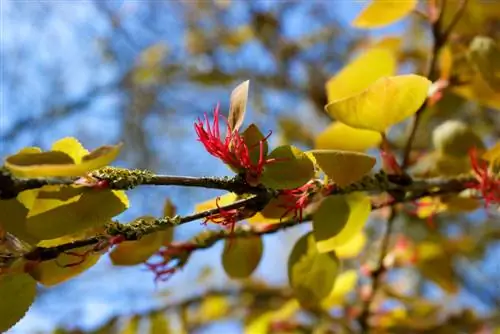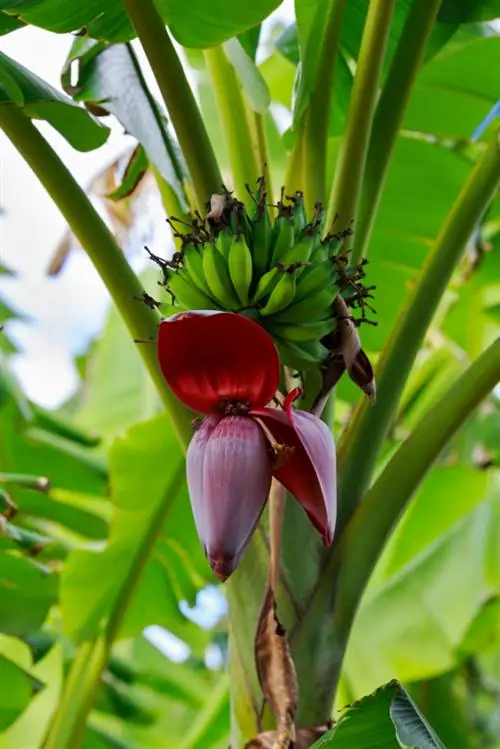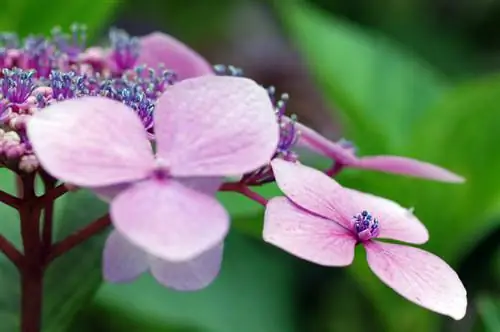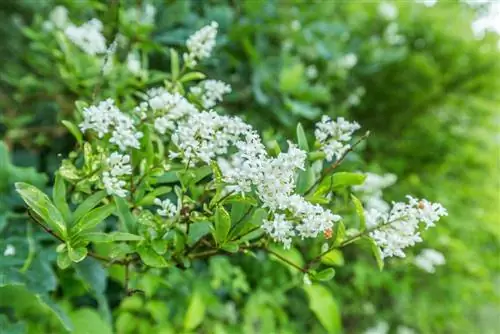- Author admin [email protected].
- Public 2023-12-16 16:46.
- Last modified 2025-06-01 06:02.
Read everything you need to know about the magnificent cake tree here. Informative details about flowering, leaves and growth. This is how you plant, care for and cut the gingerbread tree correctly.
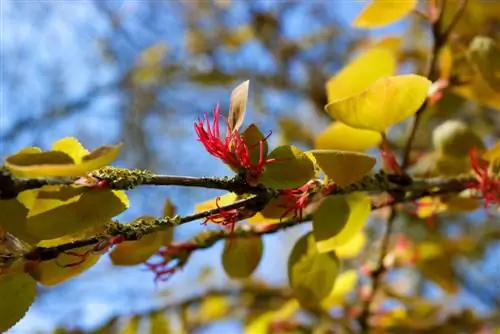
What distinguishes the cake tree in the garden?
The cake tree (Cercidiphyllum) is a decorative ornamental tree with heart-shaped leaves that smell like gingerbread and take on bright colors in autumn. It grows as a large shrub or multi-stemmed tree, reaches a height of 8-15 m and prefers nutrient-rich, fresh, moist, slightly acidic soil in sunny to partially shaded locations.
Profile
- Scientific name: Cercidiphyllum
- Genus: Cake trees with 2 species
- Synonyms: gingerbread tree, katsura tree
- Growth type: small tree, large shrub
- Growth height: 8 m to 15 m
- Growth: multi-stemmed, umbrella-shaped
- Flower: clumps
- Fruits: follicles, winged seeds
- Leaves: blunt-heart-shaped, stalked
- Roots: shallow roots
- Toxicity: non-toxic
- Use: ornamental trees
Bloom
Cake trees are dioecious with separate sexes. Male and female flowers appear on separate trees. The flowers develop before the leaves emerge. Gingerbread tree flowers can be recognized by the following features:
- Male flower: white with 10 mm long stamens, long filaments with reddish anthers
- Female flower: short-stemmed with 2 to 8 carmine-red individual flowers and 15 to 30 seed primordia
- Arrangement: in bunches
- Position: terminal
- Pollination: Wind transport
- Flowering time: March to May
If male and female cake trees are in close proximity, small brown follicles with winged, 5 mm long seeds form in autumn.
leaves
The leaves are its most beautiful decoration and hold a fragrant secret. In fact, the cake tree owes its name to the autumn foliage. Gingerbread tree leaves have the following properties:
- Leaf shape: broadly ovate, elliptical to heart-shaped
- Leaf edge: finely serrated or notched, sometimes wavy
- Leaf stems: dark red, 4 cm to 6 cm long
- Arrangement: opposite, rarely alternate
- Leaf color: bronze-colored leaves, summer green, yellow to scarlet autumn color
- Smell: in autumn like cinnamon, caramel or gingerbread
In Indian summer, the gingerbread tree celebrates a furious spectacle of bright autumn colors, as the following video impressively demonstrates:
Video: Cake tree in autumnal splendor
Growth
Cake trees grow as large shrubs or multi-stemmed trees. In the first few years, the ornamental trees form a loose, pyramidal crown. With advancing age, the crown becomes wider and becomes more rounded to umbrella-shaped. As the aging process progresses, the smooth, gray-brown bark becomes increasingly rough and peels off in strips. Individual trunks sometimes tend to twist, which creates a picturesque component in the appearance.
Roots
The Katsura tree develops a shallow root system that extends more in width than in depth. Although the ornamental tree does not form runners, the numerous topsoil roots can lift paving slabs and other paved surfaces.
Species
Cercidiphyllum is an elite genus of plants with only two species. Both ornamental trees delight in the hobby garden as a feast for the senses with bright autumn colors and a seductive gingerbread scent. The following table provides an overview of the differences:
| Cake tree species | Japanese cake tree | Magnificent cake tree |
|---|---|---|
| Scientific name | Cercidiphyllum japonicum | Cercidiphyllum magnificum |
| Growth height | 8 m to 15 m | 6 m to 10 m |
| Growth width | 4 m to 8 m | 3 m to 5 m |
| Growth | 30 cm to 50 cm | 20 cm to 30 cm |
| Leaf shape | heart-shaped | ovoid |
| Flowering time | April to May | May to June |
| Speciality | most important species | Rarity from Honshu |
Good to know for hobby gardeners with a family garden: Both cake tree species and the varieties resulting from them are not poisonous. The appetizing smell is caused by a harmless m alt sugar and not by a plant poison.
Planting a cake tree
The best time to plant is in spring. You can basically plant a cake tree from the nursery in a container or with balls all year round, as long as the ground is not frozen. A carefully considered choice of location takes account of the expansive growth. With expert soil preparation and planting techniques, you can warmly welcome the exotic ornamental tree into your garden. Read important information in the following sections:
Location
These criteria identify the optimal location for a Katsura tree:
- Sunny to partially shaded
- Nutritious soil
- Fresh, moist soil, preferably loamy-clayey
- Neutral to acidic pH value
If there are different locations to choose from, it is worth taking a pH value test (€2.00 at Amazon) from the hardware store to help you decide. The more acidic the earth, the more magnificent the autumn colors.
Soil preparation
In the natural garden, organic soil preparation is recommended in order to meet the high nutrient requirements of your Katsura tree. Ideally, you should complete the following work in the fall of the previous year, otherwise in the spring a few weeks before planting:
- Dig up the bed soil two spades deep at the location
- Garden soil ideally seven
- Rake the tire compost onto the surface (3 l per m²) and rain in
In the following weeks and months, hard-working soil organisms work to process the organic nutrients in the compost soil so that they are available for the Katsura tree.
Planting instructions
On the day of planting, place the root ball, including the container or ball cloth, in a bucket with collected rainwater until no more air bubbles appear. Meanwhile, pull out the weeds at the site and rake the soil thoroughly. How to plant a gingerbread tree correctly:
- Dig a planting pit with twice the diameter of the roots
- Mix the excavated material with a few handfuls of horn shavings as additional starting fertilizer
- Unpot the water-soaked ornamental tree, do not open the bale cloth yet
- Place the cake tree in the middle of the planting hole, open the bale cloth
- Fill with enriched soil and tamp down
- Form the watering edge out of bed soil and slurry in the Katsura tree
The planting depth should be such that the root disk is thinly covered with soil and is flush with the garden floor.
Excursus
Planting the cake tree with lots of flowers
With floral splendor, flowering perennials as underplanting bridge the waiting time until the glamorous performance in autumn. The ideal ground cover must be able to withstand root pressure and shadows. Plant fairy flowers (Epimedium), periwinkle (Vinca major) and heart-leaved foam flowers (Tiarella cordifolia) on the tree disc. These flower beauties have also proven to be excellent colorful foot soldiers for the flat-rooted maple maple.
Care for the cake tree
Cake tree care is characterized by high nutrient and water requirements. The ornamental tree reacts to drought stress by dropping its leaves. Nutrient deficiency affects growth, flowering and foliage. Pruning care is limited to light corrections and thinning out dead wood. Raising them to become a standard breed is possible. Unexpected leaf loss requires immediate action. It's worth taking a look at the following care instructions:
Pouring
As soon as the soil on the tree disc is noticeably dry, watering is required. Watering may be necessary on warm summer days even after a rain shower because the sprawling crown catches raindrops like an umbrella. A mulch layer of compost or bark mulch keeps the root disk moist longer.
Fertilize
With an organic starter fertilization in March, you can prepare the cake tree for the new vegetation phase. The best time is before flowering begins. Spread 100 grams of horn shavings and 3 liters of compost per square meter. With an eye on the shallow topsoil roots, carefully work in the organic fertilizer and water again. In June, the ornamental tree looks forward to a second helping.
Cutting the cake tree
Pruning measures should not interfere with the formation of a pyramidal, later broad umbrella-shaped crown. There are two reasons why you can still cut a gingerbread tree. The following lines explain when and how to do it correctly:
- Cutting the cake tree in February on a frost-free, overcast day
- Thimout dead branches at the beginning
- In the second step, remove or cut back unfavorable branches
Another time window for simple corrections opens at the end of June/beginning of July, provided the pruning is limited to this year's growth.
Raising to be a standard member
As a fully trained standard tree, a Katsura tree costs more than 1,000 euros if you buy the gem at the tree nursery. For this reason, hobby gardeners train the multi-stemmed ornamental tree to become a standard tree. The following quick guide explains how the project succeeds:
- Buy a cake tree as a shrub in a container (available with a height of 125 cm to 150 cm for under 50 EUR)
- Select the strongest shoot as the future tree trunk
- Cut off remaining ground shoots at the base
- Provide a support stick to the trunk shoot for straight growth
- Care up to the desired trunk height plus 20 to 40 cm
- Cut trunk shoot
- Place scissors or saw at a short distance from a bud or a sleeping eye
Below the interface, the tree trunk branches into a crown
Cake tree loses leaves - what to do?
It starts with limp leaves. If the warning signal is ignored, the beautiful, heart-shaped leaves will fall off in droves in the middle of the peak season. How to act correctly now:
- Cause: Drought stress
- Countermeasure: Water the cake tree thoroughly
- How?: Hold the water hose on the tree disc for at least 20 minutes
The acute water requirement is met when small puddles form on the root disk. From now on, water more often, but never without a finger test first, so that waterlogging does not form.
Popular varieties
The two cake tree species in the table above inspired experienced breeders for the following garden-friendly varieties:
- Hanging Katsura tree 'Pendulum': 4 m to 7 m high, multi-stemmed tree with a wide, hanging silhouette.
- Gingerbread tree 'Red Fox': multi-stemmed ornamental tree with red leaves on reddish branches, height 4 m to 6 m.
- Spherical Katsura tree 'Glowball': copper-colored foliage shoots, orange-yellow autumn color, rounded growth.
FAQ
Can you keep the cake tree in a pot?
In principle, every ornamental tree is suitable for cultivation in a container. In order for a cake tree to develop splendidly in a limited substrate volume, a continuous supply of water and nutrients is important. On hot summer days, it is usually necessary to water your thirsty katsura tree in the morning and evening. Because the roots in the pot are susceptible to frost damage, winter protection is strongly recommended.
Can I dry the leaves to preserve the gingerbread smell?
No, unfortunately the seductive gingerbread scent disappears when the leaves dry out. The typical smell comes from m alt sugar (m altose), which a cake tree produces in its leaves. This sugar decomposes when dry. For this reason, a Katsura tree smells particularly intense in damp autumn weather.
How can I identify dead branches on the leafless cake tree?
Put it to the test with a simple vitality test. Use your fingernail to scrape a piece of bark off the branch in question. If dark brown tissue appears, it is dead wood. However, if you see light to green, juicy tissue, the branch will sprout in spring.

